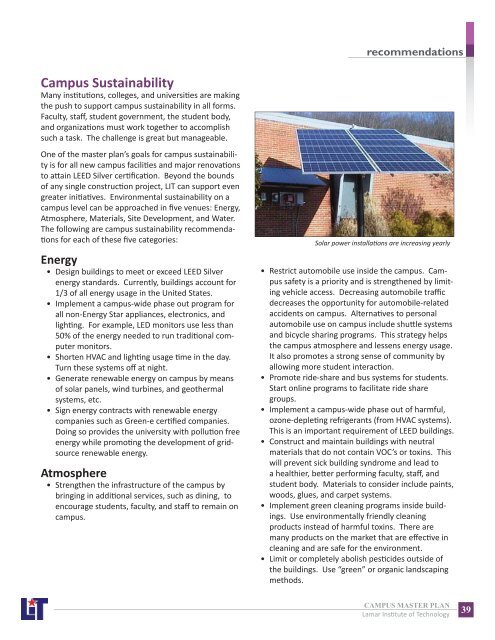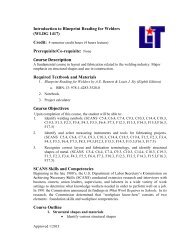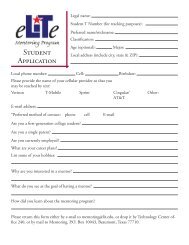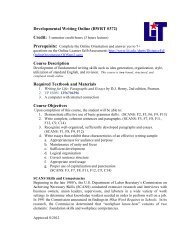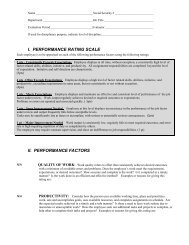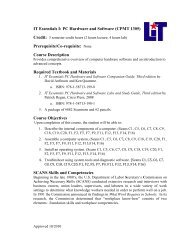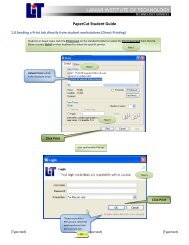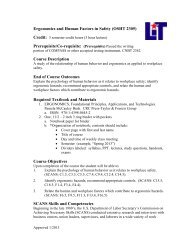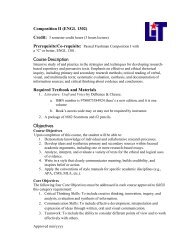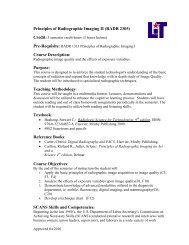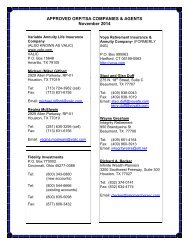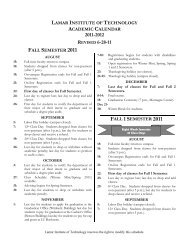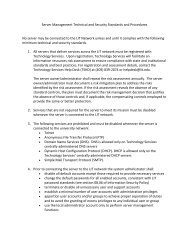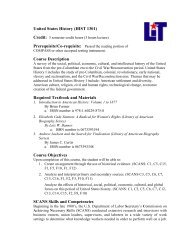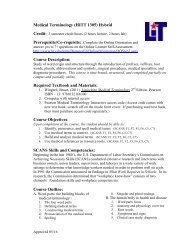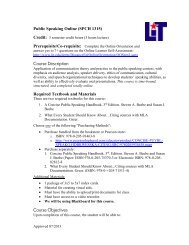LIT Master PLan PDF - Lamar Institute of Technology
LIT Master PLan PDF - Lamar Institute of Technology
LIT Master PLan PDF - Lamar Institute of Technology
Create successful ePaper yourself
Turn your PDF publications into a flip-book with our unique Google optimized e-Paper software.
ecommendations<br />
Campus Sustainability<br />
Many institutions, colleges, and universities are making<br />
the push to support campus sustainability in all forms.<br />
Faculty, staff, student government, the student body,<br />
and organizations must work together to accomplish<br />
such a task. The challenge is great but manageable.<br />
One <strong>of</strong> the master plan’s goals for campus sustainability<br />
is for all new campus facilities and major renovations<br />
to attain LEED Silver certification. Beyond the bounds<br />
<strong>of</strong> any single construction project, <strong>LIT</strong> can support even<br />
greater initiatives. Environmental sustainability on a<br />
campus level can be approached in five venues: Energy,<br />
Atmosphere, Materials, Site Development, and Water.<br />
The following are campus sustainability recommendations<br />
for each <strong>of</strong> these five categories:<br />
Energy<br />
• Design buildings to meet or exceed LEED Silver<br />
energy standards. Currently, buildings account for<br />
1/3 <strong>of</strong> all energy usage in the United States.<br />
• Implement a campus-wide phase out program for<br />
all non-Energy Star appliances, electronics, and<br />
lighting. For example, LED monitors use less than<br />
50% <strong>of</strong> the energy needed to run traditional computer<br />
monitors.<br />
• Shorten HVAC and lighting usage time in the day.<br />
Turn these systems <strong>of</strong>f at night.<br />
• Generate renewable energy on campus by means<br />
<strong>of</strong> solar panels, wind turbines, and geothermal<br />
systems, etc.<br />
• Sign energy contracts with renewable energy<br />
companies such as Green-e certified companies.<br />
Doing so provides the university with pollution free<br />
energy while promoting the development <strong>of</strong> gridsource<br />
renewable energy.<br />
Atmosphere<br />
• Strengthen the infrastructure <strong>of</strong> the campus by<br />
bringing in additional services, such as dining, to<br />
encourage students, faculty, and staff to remain on<br />
campus.<br />
Solar power installations are increasing yearly<br />
• Restrict automobile use inside the campus. Campus<br />
safety is a priority and is strengthened by limiting<br />
vehicle access. Decreasing automobile traffic<br />
decreases the opportunity for automobile-related<br />
accidents on campus. Alternatives to personal<br />
automobile use on campus include shuttle systems<br />
and bicycle sharing programs. This strategy helps<br />
the campus atmosphere and lessens energy usage.<br />
It also promotes a strong sense <strong>of</strong> community by<br />
allowing more student interaction.<br />
• Promote ride-share and bus systems for students.<br />
Start online programs to facilitate ride share<br />
groups.<br />
• Implement a campus-wide phase out <strong>of</strong> harmful,<br />
ozone-depleting refrigerants (from HVAC systems).<br />
This is an important requirement <strong>of</strong> LEED buildings.<br />
• Construct and maintain buildings with neutral<br />
materials that do not contain VOC’s or toxins. This<br />
will prevent sick building syndrome and lead to<br />
a healthier, better performing faculty, staff, and<br />
student body. Materials to consider include paints,<br />
woods, glues, and carpet systems.<br />
• Implement green cleaning programs inside buildings.<br />
Use environmentally friendly cleaning<br />
products instead <strong>of</strong> harmful toxins. There are<br />
many products on the market that are effective in<br />
cleaning and are safe for the environment.<br />
• Limit or completely abolish pesticides outside <strong>of</strong><br />
the buildings. Use “green” or organic landscaping<br />
methods.<br />
CAMPUS MASTER PLAN<br />
<strong>Lamar</strong> <strong>Institute</strong> <strong>of</strong> <strong>Technology</strong><br />
39


